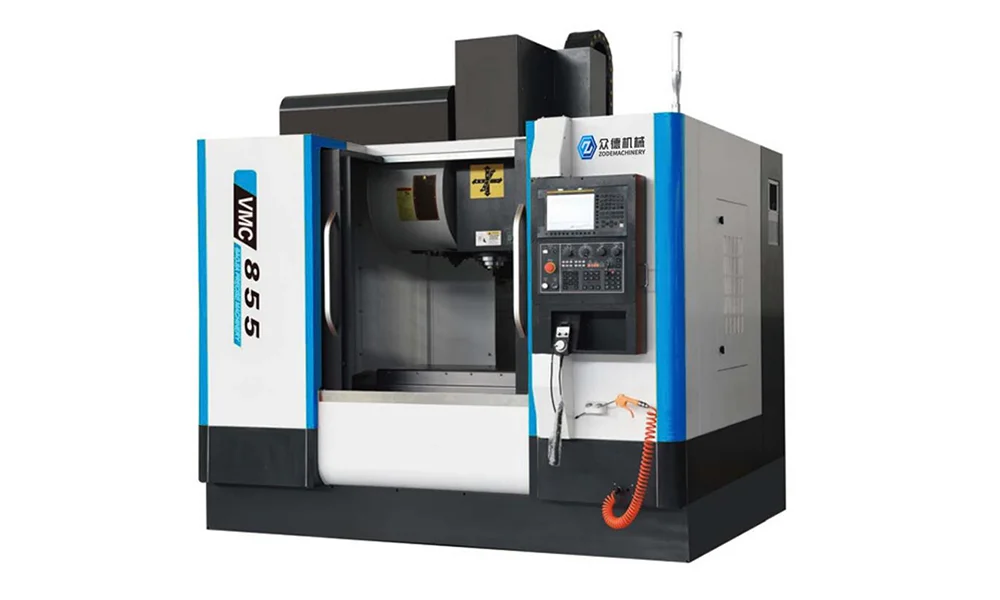- This topic is empty.
-
AuthorPosts
-
2025-08-05 at 11:58 am #86041
The high precision CNC vertical machining center (VMC) is a key component of modern manufacturing, known for its accuracy, automation, and versatility. It integrates mechanical, electrical, and computer technologies to perform complex machining tasks with minimal human intervention. In this blog post, Nantong Zode, a high performance automatic surface grinding machine supplier, will share the working principle of high precision CNC vertical machining center for sale.
Overview of CNC Vertical Machining Centers
A CNC vertical machining center is a type of automated machine tool that utilizes a vertically oriented spindle to perform various cutting operations—such as milling, drilling, boring, and tapping—on a stationary workpiece. The term "vertical" refers to the spindle orientation, which is perpendicular to the worktable. This design offers advantages in chip removal, visibility, and part loading.
High precision VMCs are extensively used in industries such as aerospace, automotive, mold manufacturing, and electronics, where tight tolerances and repeatable accuracy are essential.
Key Components of CNC Vertical Machining Center
Understanding the working principle of a high precision VMC requires knowledge of its main components:
* Spindle System: The rotating axis that holds and drives the cutting tool.
* Worktable: The platform where the workpiece is mounted.
* Linear Axes (X, Y, Z): Controlled by motors and ball screws to move the tool or workpiece precisely.
* Tool Magazine: Stores multiple tools and facilitates automatic tool changes.
* Control Panel (CNC System): The brain of the machine that interprets G-code and coordinates all motion and operations.
* Coolant and Chip Management System: Ensures thermal stability and removes chips from the machining area.
Each component plays a crucial role in achieving high precision, speed, and reliability during machining.
CNC Control System: The Brain of the Operation
The CNC control unit is responsible for processing part programs written in G-code. These programs define the tool paths, spindle speed, feed rates, and tool changes required for a given machining task. Once the program is loaded, the control system translates digital commands into precise movements of the machine' s axes and spindle.
High-end control systems support advanced functions such as:
* Tool wear compensation
* Real-time error correction
* Adaptive feedrate control
* Multi-axis interpolation
These features enhance machining precision and efficiency, especially when dealing with complex geometries.

Linear Motion and Positioning
The movement of the cutting tool or worktable in the X, Y, and Z directions is facilitated by ball screws driven by servo motors. High precision VMCs typically use closed-loop feedback systems with linear encoders or rotary encoders to monitor and adjust positioning in real-time.
The closed-loop system ensures that the commanded and actual positions match closely, significantly reducing positioning errors and maintaining tight tolerances within microns. The rigidity of the machine frame and guideways also plays a significant role in maintaining stability during high-speed operations.
Spindle Technology and Machining Accuracy
The spindle is the heart of any VMC. High precision VMCs often incorporate direct-drive spindles or integrated motor spindles, which minimize vibration and thermal growth. The choice of spindle speed (typically ranging from 6,000 to 20,000 RPM) depends on the material and machining application.
To maintain accuracy, advanced spindles include features such as:
* Thermally controlled bearings
* Automatic balancing systems
* High-resolution speed feedback
These elements contribute to consistent surface finish, tool life, and geometric accuracy of the machined parts.
Tool Change and Automation
Automatic Tool Changers (ATC) are standard in high precision VMCs, allowing seamless switching between tools during multi-operation machining. The ATC is programmed within the CNC code and executes tool changes with minimal cycle time impact.
Toolholders, tool presetting systems, and tool length measurement devices are employed to ensure correct tool offsets and maintain high precision during operations. Some advanced systems also feature in-process tool breakage detection and automatic tool calibration.
Cooling and Chip Evacuation
Thermal expansion is a major factor that can affect machining accuracy. To combat this, precision VMCs are equipped with sophisticated coolant systems that regulate the temperature of the cutting zone and spindle. The use of through-spindle coolant ensures better chip evacuation and improved cutting efficiency, especially in deep-hole drilling or high-speed milling.
Additionally, chip conveyors, air blast systems, and mist collectors help maintain a clean machining environment, preventing debris from affecting the motion system or optical sensors.
Precision Calibration and Error Compensation
Modern high precision VMCs are calibrated using laser interferometers, ball bars, and electronic levels to ensure geometric accuracy. Moreover, thermal compensation software and kinematic error mapping allow the CNC controller to correct for known deviations in real time.
These systems are critical in achieving long-term reliability and repeatability, especially in operations requiring tight tolerances over extended periods of use.
Advantages of High Precision CNC Vertical Machining Center
The working principle of a VMC is built around achieving precision through automation and control. Some key advantages include:
* Consistent Accuracy: Achieves repeatable tolerances in the micron range.
* High Productivity: Capable of unmanned machining with minimal setup changes.
* Versatility: Suitable for small batch or mass production of complex parts.
* Reduced Human Error: Automated control reduces dependency on operator skill.
These attributes make high precision VMCs an indispensable asset in competitive manufacturing environments.
Conclusion
The high precision CNC vertical machining center embodies a sophisticated integration of mechanical engineering, software intelligence, and electronic control. Its working principle is centered on executing programmed tool paths with exacting accuracy, repeatability, and speed. Through advanced components such as high-speed spindles, closed-loop servo systems, and smart CNC controllers, the VMC continues to push the boundaries of precision manufacturing.
http://www.zodemc.com
Nantong Zode -
AuthorPosts
- You must be logged in to reply to this topic.


